| | What is an environmental risk? | Environmental hazards | Environmental pathways and receptors | Taking the next steps | For more information
Environmental risks may occur anywhere on a farmstead where water supplies are located and potential contaminants exist. A producer needs to consider the entire farmstead, when identifying any potential environmental risk. Humans and animals may be at a greater risk on farmsteads, due to their proximity to hazards stored and used on the farm.
What is an Environmental Risk?
Beneficial Management Practices (BMPs) are actions that can be taken to address a potential risk and minimize or eliminate its effects.
Identifying environmental risk can become a complicated procedure, and many factors need to be considered. Since each farmstead is unique, the risks that exist on your operation need to be identified and evaluated.
Three factors must exist for an environmental risk to be present:
- There must be a hazard or contaminant present.
- There needs to be a receptor of the hazard.
- There must be a pathway that has the capacity to carry the hazard to the receptor.
A hazard is defined as any source of contamination that has the potential to negatively affect a receptor. A receptor is something that has the potential to be affected by a given hazard, usually in an adverse way. The pathway is the method by which a hazard travels from a source to a receptor. Pathways can include water, air, soil, humans, animals or any combination of these.
By using a hypothetical situation, in this case a fuel leak from a storage tank, we can define risks by identifying these three factors.
A fuel tank has a leak that goes unnoticed for a day. The fuel from the leak has moved through the gravel pad underneath the tank and into the soil. The following day, there is a major summer rainfall and the soil becomes saturated. Due to the topography of the site, water begins to flow overland and through the soil profile, towards the water well. The well is located downslope from the fuel tank, and the natural flow draws the water towards and down the side of the well casing into the aquifer. This is the well that is used by the farm family for drinking.
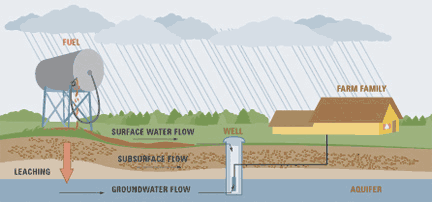
Figure 2.1. Environment risks associated with fuel storage leaks
The hazard is the fuel, while the following pathways include:
- soil containing the spill
- rainwater flowing over the ground and through the soil profile into the well
- groundwater entering the aquifer
The ultimate receptor is the farm family who drinks the water. Other receptors include:
- soil and grass – fuel-contaminated water flowing over the ground may have sterilization effects on soil and soil microbes.
- aquifer – fuel-contaminated water leaches through the soil affecting aquifer water supplies that may be used by other neighbours or farm animals.
All environmental risks need to be identified based on site-specific characteristics and you need to identify receptors and pathways based on the potential chain of events.
The rest of this chapter outlines more specific hazards and provides information on potential pathways and receptors that may exist on your operation. By reading the remainder of this chapter you will be better equipped to identify potential risks on your operation.
Environmental Hazards
Many different hazards exist on a farmstead, and when managed properly, they pose little or no threat to the environment and your family’s health. Outlined in the table below (Table 2.1) are some examples of potential hazards and their possible sources that may exist within a farmstead.
Table 2.1. Possible sources of hazards on a farmstead
| Hazards | Sources |
| Nutrients | Soil, inorganic fertilizer, manure, silage, household wastewater, compost materials, bales (organic residues) |
| Pathogens | Household wastewaters, manure, livestock mortalities, animal health care products |
| Hydrocarbons | Gasoline, diesel, kerosene, lubricants, oil |
| Salt | Feed, supplements, manure, inorganic fertilizer, hydrocarbons, pesticides, household wastewater, groundwater |
| Pesticides | Agricultural, household, garden |
| Noise | Loud machinery and equipment |
| Odour | Manure, inorganic fertilizers, silage, livestock mortalities, decomposing plant and animal residues |
| Dust and Smoke | Vehicle and machinery traffic, burning residues or wastes |
| Other Chemicals | Pharmaceuticals, cleaning solutions, aerosols, paints, solvents, stains, automotive fluids, refrigerant and air conditioning freons, farm wastes |
Nutrients
Nutrients are essential for plant growth, but excess nutrients beyond plant needs may potentially become hazards. Sources of nutrients include chemical fertilizers, animal manures, household wastewaters, silage, soil and composted materials. Two nutrients of primary concern are nitrogen (N) and phosphorus (P).
There are three ways nutrients can move and potentially contaminate receptors (see Figure 2.2). Nutrients can either dissolve in water, bind to soil particles or be released in a gaseous form to the atmosphere.
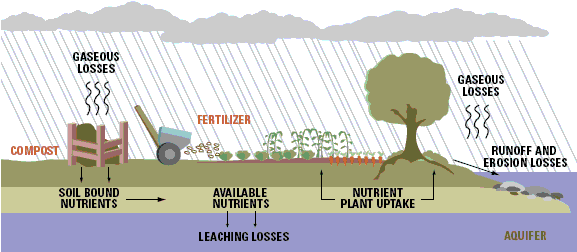
Figure 2.2. Possible nutrients lost by leaching, in runoff or as gases
Nutrients dissolved in water can potentially enter water bodies as runoff during snow melt, rainfall or irrigation. Dissolved nutrients can also be carried downwards through the soil profile by leaching, potentially entering groundwater supplies.
Nutrients bound to soil particles are susceptible to water and wind erosion, potentially contaminating water bodies. Soils, which are not subjected to erosion or runoff, will help hold nutrients allowing them to be released over time.
Nitrogen (N) can be released into the atmosphere in gaseous forms such as nitrous oxide (N2O) or nitrogen gas (N2). Nitrous oxide (N2O) is one of the major contributors to greenhouse gases. Nitrogen can also be lost to the atmosphere as ammonia (NH3), creating odours. More discussion on greenhouse gases and odours can be found later in this chapter.
Too much nitrogen in water supplies, in the form of nitrates (NO3), can harm livestock and humans. Drinking water with high nitrate levels may cause nitrate poisoning, which reduces the amount of oxygen absorbed by body tissues. In human babies, this condition is known as “blue baby” syndrome, causing the skin to turn a bluish colour, particularly around the eyes and mouth. Livestock show symptoms of nitrate poisoning by having problems standing up and staggering. With prolonged exposure, excessive nitrate levels can eventually be fatal.
Elevated nutrient levels, particularly with phosphorus (P), degrade surface water quality by promoting excessive growth of aquatic plants and algae. Algal blooms exhaust the supply of oxygen, during growth and decomposition. During decomposition, microorganisms breakdown organic material, removing dissolved oxygen from the water. This reduction of oxygen can result in the death of fish and other aquatic organisms. Some types of blue-green algae can also release toxins deadly to livestock and humans during decomposition. Algae can also block water intakes, reduce the appeal of water bodies for recreation and give an unpleasant taste and odour to drinking water.
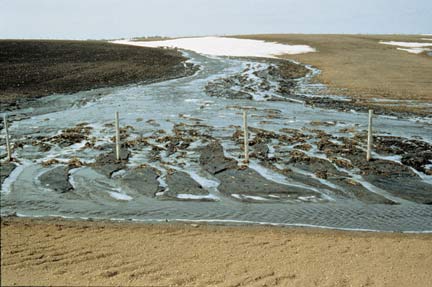
Water erosion carries nutrients in the topsoil off-site, potentially contaminating nearby water bodies
Courtesy of AAFRD
Pathogens
Microorganisms such as bacteria, parasites, protozoa and viruses occur naturally in animals, humans, soil and water. Pathogens are disease-causing microorganisms that can infect other animals and humans resulting in severe or fatal illnesses. A few common pathogens associated with farmsteads are Escherichia coli (E. coli), Salmonella species, Cryptosporidium parvum (“crypto”) and Giardia lamblia (“beaver fever”).
Pathogens can travel to humans and livestock through air, soil and water pathways but their survivability is limited by environmental conditions once they are shed or excreted by their host. Some pathogens can survive freezing or low temperatures for extended periods of time, while other pathogens may survive for much shorter periods in warm temperatures.
Water is an important transmitter of pathogens. People who drink contaminated water or eat contaminated food will more than likely become ill. Infection and illness may also occur in people using contaminated water for recreational purposes.
Pathogens can contaminate food sources either through direct surface contamination or indirect contamination from soil and water. In addition, raw or inadequately cooked food, in particular meat and eggs, and non-pasteurized fruit juices and dairy products can potentially infect people.
Pathogens can potentially transfer between animals and people through direct and indirect contact. Common pathways of transmission include contact with animals, animal manure, contaminated animal products, feed or equipment (see Figure 2.3). Activities that potentially increase the risk of infection include working closely with livestock, treating sick animals, hunting or processing animal products for food. Person-to-person transmissions can occur as well, especially when infected people do not use proper hygiene such as washing hands before cooking or eating, or after using the washroom.
Through proper management practices, producers can minimize their risk of pathogen infection and the introduction of pathogens to the food chain and the environment. Using proper personal hygiene, food handling, processing and cooking procedures can prevent transmission. Good animal care, sanitary livestock facilities and sound manure management practices will also significantly reduce or completely stop the transmission of pathogens from animals to people.
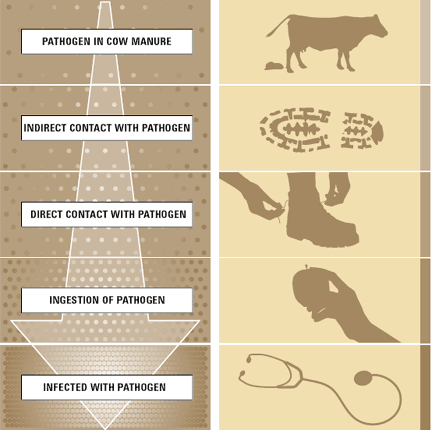
Figure 2.3. An example showing pathogen transfer from cattle to people
Hydrocarbons
Hydrocarbons are currently the world’s main source of heat and power. Fuels and lubricants contain hydrocarbons that can be hazardous to the environment. Human health risks are also associated with these products, but this manual focuses on environmental risks. Additional information on health risks can be found in Material Safety Data Sheets (MSDS) available from your fuel delivery company.
Products containing hydrocarbons such as gasoline, diesel and kerosene can be explosive and very volatile. The build up of vapours in an area can be toxic to humans or livestock. Thus when working with fuels, work in a well-ventilated area, and follow all safety precautions such as wearing goggles, gloves, coveralls and masks.
Fuels can potentially contaminate water bodies and water sources by moving quickly over and through the soil. Fuel can flow over the soil surface with runoff into surface water bodies or migrate downwards through the soil into groundwater supplies. It only takes a few litres of gasoline to severely pollute a farmstead’s drinking water. The water may smell and taste fine, but may still be contaminated even though the amount of contaminant is small. Most soil and water contamination occurs when there is a fuel spill or a leak.
Salts
Salts occur naturally in the soil and are also found in hydrocarbons, inorganic fertilizers, feed, supplements, manure, some pesticides and household wastewater.
Salts in a saline seep where salty groundwater discharges and salts that are applied to land in excess alter the soil structure and reduce a soil’s capacity to hold water. In the case of septic fields, high salinity in the soil decreases the field’s ability to treat the wastewater and ultimately shortens the life of the system. The salts will also alter soil pH and limit the growth of certain types of vegetation. Remediation of saline areas is possible, but the cost is high and results are not observed for a long time.
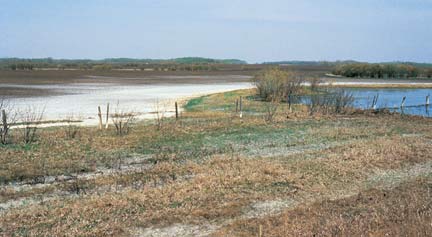
Saline seeps form where saline groundwater comes to the soil surface
Courtesy of AAFRD
Pesticides
Pesticides are designed to supress or kill target plants, fungal diseases, insects, animals and pathogens. Types of pesticides used in farmstead management include herbicides, fungicides, insecticides, rodenticides, pesticide-treated seed and topical parasiticides (pour-on or powders for treating parasites on livestock).
Pesticides can be a risk to non-target organisms if these products are not handled and applied properly. They can be carried great distances from target areas or application sites to non-target areas in several ways:
- dissolved in runoff water moving away from target areas
- attached to soil particles and carried by wind or runoff water
- spray drift onto water bodies and vegetation
Drift toward farmsteads and other residences can also damage gardens, trees and may create human health problems.
While some pesticides degrade quickly in the environment, others can persist over a significant time period, accumulating in the tissue of organisms through a process called bioconcentration. With every step in the food chain, larger quantities of the accumulated pesticide are consumed. This accumulation, called biomagnification, may continue to the point where animals are harmed or become unsafe for human consumption (see Figure 2.4).
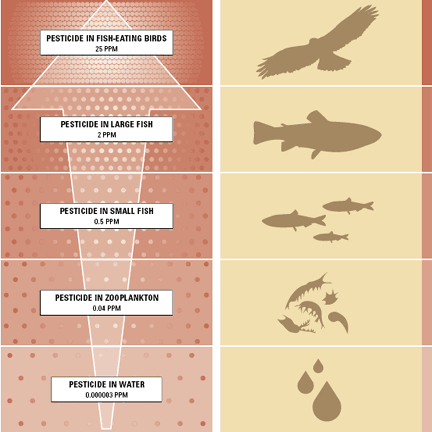
Figure 2.4. Biomagnification
Although most pesticides currently used are not toxic to humans, there is the potential for acute or chronic problems if pesticide label directions are not followed. Proper storage and handling practices should be followed to reduce risks associated with pesticide use. Knowledge of the chemical, proper application practices and disposal are the bases for responsible pesticide use in and around the farm.
Odours
Sources of odours on the farm can include compost, manure, commercial fertilizers, silage, decomposing organic matter, livestock mortalities and household wastewaters. Odours differ depending on the source and the receiver’s response to the smells themselves. Most of the odours from the above mentioned sources are a result of ammonia (NH3) and hydrogen sulphide (H2S) gas levels.
Odour is generally considered a nuisance rather than a health risk to neighbours because of the degree of dilution and dispersion that occurs within short distances from the odour source. Here the discussion includes human response to odour, which is unique for each person and extremely variable, and the environmental factors of the site, which can be managed to reduce the environmental risk to air quality.
It is difficult to evaluate odour and its effects for the following reasons:
- Odour from manure is made up of about 160 compounds. Humans have varied responses to these compounds.
- The proportion and characteristics of odour contributed by each of the primary sources (barns, storages and land application) are not well understood. Research is underway to characterize odours released from each of these sources.
- Odour intensity and offensiveness varies between individuals.
- The combination of different odours can have positive and negative effects on intensity and offensiveness. These effects are not easily predicted.
However, there are management practices that can control odour within reasonable limits. Odour mitigation practices should focus on reducing the nuisance to neighbours, by minimizing the frequency, intensity, duration and offensiveness of odours.
While research and development are underway to find solutions for odours, the following factors should be considered:
- To date, no technology emerges as a clear choice for the industry because of costs (real and perceived) associated with implementation and long term operation of the technology.
- The technology to completely prevent and remove odour either does not exist or is prohibitively expensive to install and/or manage.
- Many odour control technology studies have focused on mitigation of odour at a particular location of the operation or reducing emissions from a single source.
- Effective odour control strategy for a livestock operation may require using more than one technology or management practice.
- More research is needed to further evaluate the effectiveness of some of the odour control technologies that have been tested.
Greenhouse gases and agriculture production
Water vapour (H2O), carbon dioxide (CO2), methane (CH4), ozone (O3), nitrous oxide (N2O) and halocarbons (used in refrigerants) are the main greenhouse gases in the atmosphere. The trapping of heat by these gases controls the earth’s surface temperature. Emissions from human activities are important additional sources of greenhouse gases. Increasing concentrations of these gases are believed to increase global warming. Global warming may affect water quality and quantity and may result in problems such as more severe or extreme weather events like tornadoes, droughts, winter storms and more forest fires.
Dust and Smoke
Dust creates environmental problems and social concerns. It may contain nutrients, diseases, seeds, pollen and plant tissue, as well as agrochemicals, such as pesticides. These materials can cause health problems such as respiratory problems and, in the case of pesticides, contaminate non-target areas. As well, dust from road travel or farming activities such as tillage, harvest or manure hauling can reduce visibility on nearby roadways and may result in traffic accidents.
Smoke from burning brush or other farm wastes can create similar problems to dust. Burning wastes on the farm has been a common practice for years, but there are hazards associated with this practice. Depending on the type of waste, various by-products can be produced while burning that can cause respiratory concerns for animals and humans. As well, the ash left behind can be contaminated with heavy metals that should be disposed of properly. When burning wastes on the farm, it is important to sort them and consider other disposal alternatives. For more information on managing farm wastes, refer to Chapter 8 in this manual.
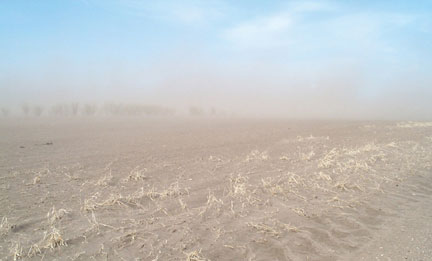
Dust generated from farming activities can increase environmental risks
Courtesy of PFRA
Other Chemicals
All chemicals found on the farm are potential hazards to the environment if not managed and disposed of properly. There are other farm chemicals besides pesticides that need to be managed with the same care and responsibility.
Some of these other chemicals include:
- animal and human pharmaceuticals (expired, banned and unused antibiotics, vaccines, etc.)
- cleaning solutions, stain removers, disinfectants, aerosols
- paints, stains, adhesives
- automotive fluids (antifreeze, transmission fluids, etc.)
- freon (from refrigerants and air conditioning units)
For further information on how to deal with hazardous chemicals, refer to Chapter 8.
Environmental Pathways and Receptors
After reviewing farmstead environmental hazards, it is necessary to look at pathways and receptors as the final requirements to defining a risk. A receptor is something that has the potential to be affected, usually in an adverse way, by a given hazard. The pathway describes how that hazard travels from a source to a given receptor. Pathways can include water, air, soil, humans, animals or any combination of these. Remember that some pathways can also be considered receptors depending on the chain of events when a hazard is released.
Water, soil and air pathways can become quite complex and intertwined, making it easy to overlook a potential risk. The following sections provide more information to help you better identify the environmental risks and potential receptors on your farm.
Water
Within a farmstead, water can be found in various locations including permanent water bodies such as creeks, dugouts, ponds, lakes, sloughs and groundwater aquifers. Water bodies can also include intermittent water resulting from runoff created by snow melt and rainfall. Although these waters exist temporarily, they can serve as pathways that can transport hazards to receptors. The water cycle in Figure 2.5 demonstrates water movement and outlines how surface water and groundwater are interconnected.
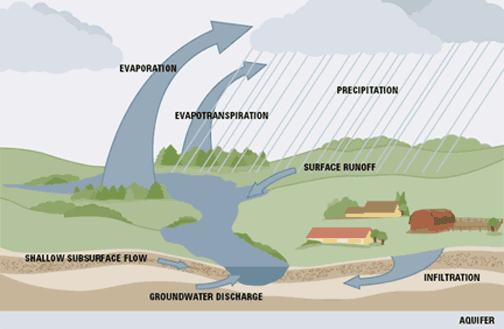
Figure 2.5. Water cycle
When water has a specific use, it can be considered a receptor and therefore becomes a concern. Specific uses include domestic or livestock consumption, irrigation, recreation and habitat for aquatic life. How a water source is evaluated will also depend on the connection between the surface water and groundwater at the site and the potential for water to move offsite. If water moves offsite, whether above or below ground, the concern is that you no longer have control of it and the hazard it may carry.
To effectively reduce environmental risks, the goal is to manage water pathways. This could include controlling the movement of water and providing an opportunity for the hazard to be treated before flowing into a significant water body if possible.
The following factors that affect water pathways should be considered when developing action plans to reduce risks:
- Most runoff comes from spring snow melt and presents a great risk to surface water, potentially contaminating it as the soil is still frozen and water infiltration is limited.
- Infiltration of water is slower in fine-textured soils (clay), increasing the amount of runoff from these soils into surface water.
- Infiltration of water is faster in coarse-textured soils (sand), increasing the amount of water that will infiltrate the soil and reach groundwater.
- Long and steep slopes will increase the speed at which water will travel, reducing water infiltration rates and capture of hazards.
- Packed soils and paved surfaces, as found in farmsteads, will reduce infiltration and increase surface water runoff.
- Permanent vegetation cover within the pathway will slow water down and can, in turn, capture hazards both dissolved and in soil particles. Depending on the hazard, this approach may be a form of treatment reducing the risk.
Soil
Soil is made up of four major components: organic matter, mineral particles, water and air. Soil can be considered a receptor when it contains hazards either dissolved in the water component, as vapours in the pore spaces or physically attached to soil particles. If the movement of soil through water and wind erosion provides a way for these hazards to move to other soils or into water, then the soil becomes a pathway.
Soil characteristics can determine the seriousness of risk that may occur. High organic matter soils will be less susceptible to erosion or movement by water and wind. These soils will hold more water and therefore more nutrients and other hazards. On the other hand, high organic matter soils will contain more microbes that may be able to treat or breakdown hazards.
Typically within a farmstead, many areas will have compacted soils. Roadways, equipment storage areas and building floors all have reduced permeability, increasing the surface movement of water and potential hazards. This movement may carry hazards into areas of your farmstead where surface water and groundwater are located or connected, increasing the risk to these water sources.
To effectively reduce environmental risk, the management options of soil pathways could include controlling the movement of the soil and maintaining healthy soils that will increase the chance for the hazard to be treated.
The following factors affect soil pathways and should be considered when developing action plans to reduce risks:
- Roadways and some equipment storage areas will not have the ability to absorb water and will increase runoff of water. The direction of the runoff water should be considered when looking at environmental risks. Due to poorer structure and less organic matter, these soils will be unable to treat some hazards.
- Soil covered by plants or plant residues is less susceptible to water erosion than bare soil. Growing plants and a crop residue cover absorb the energy of raindrops and slow the flow of runoff, reducing the risk of erosion. Roots hold soil in place and contribute organic matter, which further stabilizes the soil.
Air
Air can be another pathway through which a hazard may travel. Air pathways allow hazardous materials to move through the environment from a source to a point of contact with receptors. For instance, the release of hazardous materials can have an effect downwind.
Air pathways are governed by wind speed, wind direction, topography of the land and the climate of the area such as temperature and rainfall. The point of contact will change as quickly as the wind changes its direction and speed, so the effect of the air pathway may cover larger areas than those of soil or water pathways. Compared to other pathways, exposure by air pathways is generally hard to predict.
The form and chemical makeup of the hazardous materials influence how they are dispersed into the environment. Some hazards will evaporate when exposed to air; others can be suspended in the air as very small particles. They can become attached to dust or soil particles, or they can be dissolved in fine water droplets, both of which are then moved by wind.
To effectively reduce environmental risks associated with air pathways, consider controlling the movement of air and reducing the incidence of hazards in the air.
Humans and Livestock
Human and livestock activities can transfer hazards such as pathogens and diseases. The term biosecurity refers to precautions taken to reduce the risk of introducing livestock or poultry diseases to a farm or region where the disease does not already exist. Examples of common biosecurity practices include quarantining new stock, controlling rodents, providing animal and worker foot baths, cleaning equipment, cleaning footwear and changing coveralls.
Biosecurity is important because it can:
- Prevent the introduction of diseases from other countries, such as foot-and-mouth disease. These foreign diseases can spread quickly, resulting in the loss of export markets. They can also have severe economic consequences for the entire livestock industry.
- Prevent the spread of certain diseases already found in Alberta, such as transmissible gastroenteritis in pigs or Johne’s disease in cattle. These diseases can have a significant financial effect on a farm operation, and visitors could potentially be held liable if proven to be the cause of an outbreak.
- Protect the operator and his or her family from diseases found in animals that are transmissible to humans, such as salmonella, E. coli 0157:H7 and campylobacter.
- Be an indicator of the operation’s commitment to the health of the livestock and poultry industry, as well as to its visitors.
A biosecurity program should be practiced by anyone who owns or works with livestock, and visits farms, stockyards, abattoirs or premises where livestock or poultry products are handled, and attends auction markets and livestock shows.
A complete farm biosecurity program will cover the following:
- incoming stock
- vaccinations
- feedstuffs
- water
- pets
- pest control (birds, rodents, wildlife, insects, etc.)
- farm visitors
A biosecurity plan cannot meet the needs of all farms or agricultural businesses. The diseases and potential risks vary between livestock species and depend on the activities occurring on the premises. For example, a pig barn may have stricter requirements than a bison operation or a purebred breeder may have higher standards than a feedlot operator. Each business must assess their own potential risks and develop a flexible and practical biosecurity plan tailored to its circumstances.
Biodiversity on the farmstead
Once you have identified and considered environmental risks on your farmstead, you need to take a step back and look at the entire farmstead. Biodiversity is one benefit of having a well-managed farm. The loss of biological diversity can decrease future land use opportunities and threaten sustainability as biodiversity is an important part of various ecological processes.
Biodiversity helps ensure that the environment can handle hazards. For instance, having a well-vegetated water pathway with a wide variety of plant and soil microbe species can act as a buffer to manage hazards that may exist. This also slows water down as it cycles in its natural system and allows the environment to filter out hazards as they pass through the system. If there are many plants of the same species, the chance that a species will survive if a hazard affects its growth is reduced. With a diverse number of species, there is a greater chance that at least one, or a combination of more will survive and be able to reduce risks due to the hazard.
Taking the Next Steps
The steps in assessing environmental risk include the following:
- Identify all potential hazards, pathways, receptors and combinations of these on your operation.
- Determine the likelihood that receptors would be at risk because of those hazards.
- Assess the level of effect these risks have to determine their seriousness and what level of action is required.
- Identify reasonable actions or beneficial management practices that are necessary to manage high-risk situations.
This Environmental Manual for Alberta Farmsteads will give you a start at dealing with environmental risks on your farm and provide you with some beneficial management practices or options to address them. Listed at the end of this chapter are other manuals that provide more information about managing risks on other aspects of farming operations.
In Alberta, a producer organization administers a program to help you identify and assess environmental risks on your operation. For more information on doing a self-assessment of environmental risks on your farm, contact the Alberta Environmental Farm Plan Company (AEFP Co.). Their contact information is in the For More Information section at the end of this chapter.
For More Information
All Alberta government offices may be reached toll-free by dialing the Rite Line: 310-0000
Alberta Agriculture and Rural Development
Publications: 1-800-292-5697
Ag-Info Centre: 310-FARM (3276)
Website: www.agric.gov.ab.ca
Alberta Environment
Publications: 780-427-2700
Pesticides in Surface Waters – Facts at your Finger Tips Pub #1/10011
Information Centre: 780-427-2700Website: www.environment.alberta.ca
Agriculture and Agri-Food Canada
Publications: 613-759-6610
Agriculture and Climate Change
The Health of Our Air
Website: www.agr.gc.ca
Agriculture and Agri-Food Canada – Prairie Farm Rehabilitation Administration
Contact your regional office
Water Quality Matters Fact Sheets
Website: www.agr.gc.ca/pfra
Pest Management Regulatory Agency
Publications: 1-800-267-6315Website: www.pmra-arla.gc.ca
Alberta Environmental Farm Plan Company
Office: 1-866-844-2337Website: www.albertaefp.com
Canadian Cattlemen’s Association
Office: 403-275-8558
- Greenhouse Gas Sinks and Sources Tour Guide for Canadian Beef Producers
Website: www.cattle.ca |
|